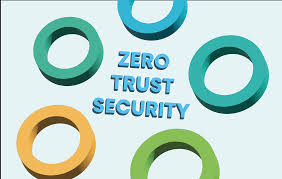
Zero Trust Security adoption in enterprises
Zero Trust Security transforms enterprise cybersecurity by assuming no trust for users or devices. Through continuous verification, least-privilege access, micro-segmentation, and real-time monitoring, it mitigates risks from insider threats, ransomware, and cloud vulnerabilities. While adoption challenges exist, technologies like MFA, EDR, and IAM enable effective implementation.
✨ Raghav Jain

Introduction
In today’s digital-first world, enterprises face an ever-growing range of cybersecurity threats. Traditional security models that rely on perimeter-based defenses—trusting users and devices inside the network—are no longer sufficient. The rise of remote work, cloud applications, and mobile devices has blurred network boundaries, making organizations more vulnerable to attacks.
Enter Zero Trust Security (ZTS): a modern cybersecurity framework that operates on the principle of “never trust, always verify.” Instead of assuming users or devices inside the network are safe, Zero Trust continuously authenticates and validates every access request, minimizing the risk of breaches and data leaks.
In this article, we’ll explore what Zero Trust is, why it’s essential for enterprises, its benefits, and practical strategies for adoption, along with daily and weekly practices to ensure robust security posture. In today’s digital landscape, enterprises face increasingly sophisticated cyber threats, data breaches, and insider risks. Traditional security models, which relied heavily on perimeter defenses such as firewalls and VPNs, are no longer sufficient. These older models operate under the assumption that everything inside the network is trustworthy, leaving organizations vulnerable when attackers gain access. In response, the Zero Trust Security model has emerged as a modern framework that emphasizes strict verification, continuous monitoring, and minimal implicit trust. Unlike conventional approaches, Zero Trust assumes that threats exist both outside and inside the network and that every access request must be verified before granting privileges.
The adoption of Zero Trust Security in enterprises has gained momentum because of the rising adoption of cloud services, remote work, and mobile devices. With employees accessing corporate data from multiple locations and endpoints, the traditional network perimeter has effectively dissolved. Enterprises are increasingly recognizing that relying solely on firewalls or secure gateways cannot adequately protect sensitive information. Zero Trust provides a paradigm shift by enforcing the principle of “never trust, always verify.” This involves verifying every user, device, and network connection, regardless of location, and continuously monitoring their activity to detect anomalies.
Implementing Zero Trust requires enterprises to rethink how access is granted. Identity and access management (IAM) becomes central to security, ensuring that users have only the minimal level of access necessary to perform their roles. Multi-factor authentication (MFA) and strong credential management are critical components, as they reduce the risk of compromised accounts. Beyond user verification, device posture assessments ensure that only secure and compliant devices can connect to enterprise resources. This involves checking for up-to-date software, security patches, and endpoint protection before granting access. By combining user and device verification, enterprises create multiple layers of defense that make it harder for attackers to exploit vulnerabilities.
Network segmentation is another fundamental aspect of Zero Trust adoption. By dividing the network into smaller, isolated zones, enterprises can limit the lateral movement of threats if a breach occurs. Even if an attacker gains access to one segment, they cannot easily traverse the entire network. This segmentation also facilitates granular access control, allowing administrators to define specific policies for each application, system, or data repository. Microsegmentation, a more advanced form of this approach, further enhances security by applying access rules at the workload level, particularly in cloud and hybrid environments.
Enterprises adopting Zero Trust also benefit from continuous monitoring and analytics. Security information and event management (SIEM) systems, combined with artificial intelligence (AI) and machine learning, allow organizations to detect unusual behavior in real-time. Suspicious activities, such as login attempts from unusual locations, abnormal data transfers, or attempts to access restricted resources, trigger immediate alerts. This proactive approach enables enterprises to respond swiftly, minimizing potential damage and preventing data exfiltration. By integrating these monitoring capabilities with automated response mechanisms, Zero Trust reduces the reliance on human intervention, making security operations more efficient and effective.
While the advantages of Zero Trust are significant, adoption is not without challenges. Enterprises often face complexity when integrating existing legacy systems into a Zero Trust architecture. Many older applications were not designed with granular access control or identity verification in mind, requiring modifications or replacements. Additionally, the cultural shift required for Zero Trust adoption can be substantial. Employees and stakeholders must understand that strict access controls and continuous verification are not obstacles but essential safeguards. Training, clear communication, and gradual implementation are often necessary to ensure successful adoption and user compliance.
The financial and operational implications of Zero Trust adoption also require careful consideration. Enterprises must invest in IAM solutions, endpoint security tools, network segmentation technologies, and monitoring systems. While these investments may seem significant, the long-term benefits—reduced risk of breaches, compliance with regulatory requirements, and protection of intellectual property—often outweigh the costs. Moreover, regulatory pressures, such as data privacy laws and industry-specific standards, are driving organizations to implement stronger security frameworks, making Zero Trust not just a strategic choice but a compliance necessity.
Zero Trust Security adoption in enterprises is increasingly viewed as a journey rather than a one-time project. Organizations often begin by identifying critical assets and high-risk areas, gradually implementing access controls, device verification, and monitoring. Pilot programs and phased rollouts help organizations learn, adapt, and scale their Zero Trust strategies effectively. As cloud adoption, remote work, and digital transformation continue to accelerate, enterprises recognize that Zero Trust is not optional but essential for maintaining resilience against cyber threats.
In conclusion, the adoption of Zero Trust Security represents a fundamental shift in enterprise cybersecurity. By moving away from perimeter-based models and embracing the principle of “never trust, always verify,” organizations can better protect their data, systems, and users. Zero Trust provides a layered defense strategy through identity verification, device compliance, network segmentation, and continuous monitoring, making it significantly harder for attackers to succeed. While challenges exist in integrating legacy systems, managing costs, and driving cultural change, the long-term benefits of reduced risk, regulatory compliance, and operational efficiency make Zero Trust a critical framework for enterprises navigating today’s complex threat landscape. Enterprises that embrace Zero Trust proactively are better positioned to withstand cyber threats, safeguard sensitive information, and maintain trust with their stakeholders.
Understanding Zero Trust Security
Zero Trust Security is built on three fundamental principles:
Verify Explicitly
Every access request, whether from an internal user or external partner, is authenticated using multi-factor authentication (MFA), identity verification, and device health checks.
Least Privilege Access
Users and devices are given only the permissions necessary to perform their tasks. No one is trusted by default, minimizing potential attack surfaces.
Assume Breach
Security systems are designed assuming attackers are already inside the network. Continuous monitoring, segmentation, and micro-perimeters prevent lateral movement.
Key Components of Zero Trust Architecture
- Identity and Access Management (IAM)
- Multi-Factor Authentication (MFA)
- Device Security & Endpoint Detection
- Network Segmentation & Micro-Segmentation
- Continuous Monitoring and Analytics
- Encryption for Data in Transit and at Rest
Why Enterprises Need Zero Trust
Enterprises face complex security challenges:
- Remote Work & BYOD Policies
- Employees accessing corporate resources from home or personal devices increase attack surfaces.
- Cloud Adoption
- Cloud services introduce distributed environments where perimeter-based security cannot provide full protection.
- Sophisticated Cyber Threats
- Ransomware, phishing, insider threats, and advanced persistent threats (APTs) are increasingly bypassing traditional defenses.
- Regulatory Compliance
- Standards like GDPR, HIPAA, and CCPA require strict data access control and monitoring.
Zero Trust addresses these challenges by continuously verifying identities, devices, and behavior, making breaches less likely and containment faster.
Benefits of Zero Trust Security in Enterprises
- Enhanced Security Posture
- Continuous verification prevents unauthorized access and reduces the risk of breaches.
- Minimized Lateral Movement
- Micro-segmentation ensures attackers cannot move freely across the network if they compromise a single system.
- Improved Visibility & Analytics
- Real-time monitoring provides insights into user behavior and potential threats.
- Regulatory Compliance Simplified
- Zero Trust ensures strict access controls, making audits and compliance easier.
- Supports Modern Work Environments
- Remote access, cloud services, and mobile devices can securely connect without exposing sensitive resources.
- Reduced Impact of Insider Threats
- Even trusted employees are restricted by least privilege policies, preventing data misuse.
Steps to Implement Zero Trust in Enterprises
1. Assess Your Current Security Posture
- Conduct a comprehensive audit of all users, devices, applications, and data.
- Identify high-value assets and sensitive information.
- Map existing access policies and potential gaps.
2. Define a Zero Trust Strategy
- Set clear goals for adoption, including protection priorities.
- Determine which systems require strict access controls and which can have more flexibility.
- Develop a roadmap for incremental implementation.
3. Strengthen Identity and Access Management
- Implement multi-factor authentication (MFA) for all users.
- Enforce strong password policies and periodic credential rotation.
- Introduce role-based or attribute-based access control (RBAC/ABAC).
4. Segment Your Network
- Create micro-perimeters around critical assets.
- Limit lateral movement with strict access rules.
- Monitor network traffic continuously for anomalies.
5. Secure Devices & Endpoints
- Require endpoint security software on all devices.
- Ensure devices are updated with the latest patches.
- Validate device posture before granting access.
6. Monitor and Analyze Behavior
- Use analytics to detect unusual login attempts, file access, or system behavior.
- Automate alerts and responses to suspicious activity.
- Regularly review logs for compliance and potential threats.
7. Educate Employees
- Conduct cybersecurity awareness training.
- Emphasize the importance of reporting suspicious activity.
- Encourage strong personal security habits.
Daily Practices for Zero Trust in Enterprises
- User Authentication Checks: Verify access requests for high-priority systems daily.
- Endpoint Monitoring: Ensure all devices connecting to the network meet security standards.
- Update Security Policies: Review user permissions and access logs each day.
- Threat Detection: Scan for unusual behavior in real-time.
- Data Backup & Encryption: Encrypt sensitive data and ensure daily backups are performed.
Weekly Zero Trust Routines
- Conduct vulnerability assessments and patch updates.
- Review access rights and modify based on role changes.
- Simulate potential attack scenarios to test micro-segmentation effectiveness.
- Update threat intelligence feeds and adjust monitoring rules.
- Engage IT staff in awareness refreshers and zero trust best practices.
Common Challenges in Zero Trust Adoption
- Complexity in Implementation
- Integrating Zero Trust with existing infrastructure can be challenging. Start small with high-risk areas and scale gradually.
- Employee Resistance
- Some employees may find MFA and frequent verification inconvenient. Proper training and communication are essential.
- Legacy Systems
- Older applications and devices may not support advanced Zero Trust features, requiring careful integration or replacement.
- Cost & Resource Allocation
- Initial investment in software, monitoring, and training may be significant, but the ROI in breach prevention is far greater.
Zero Trust Myths: Busted!
“Zero Trust means no trust at all.”
→ Not true. It means trust is earned and verified continuously, not assumed by default.
“Zero Trust only applies to large enterprises.”
→ False. Small and medium businesses benefit equally, especially with cloud adoption.
“Once implemented, Zero Trust is set and forget.”
→ Incorrect. Continuous monitoring, updates, and policy refinement are required.
“Zero Trust replaces all other security measures.”
→ Not exactly. It complements existing cybersecurity controls and enhances overall security.
“Zero Trust slows down productivity.”
→ Properly designed Zero Trust balances security with user experience, minimizing friction while protecting assets.
Sample Zero Trust Adoption Plan for Enterprises
Phase 1 – Discovery & Assessment
- Audit assets, users, and current security posture
- Identify critical systems and sensitive data
Phase 2 – Identity & Access Controls
- Implement MFA, RBAC/ABAC, and password policies
- Introduce device verification and posture checks
Phase 3 – Network & Endpoint Security
- Segment the network into micro-perimeters
- Enforce endpoint protection and patch management
Phase 4 – Continuous Monitoring & Analytics
- Deploy real-time monitoring tools
- Set up automated alerts and response workflows
Phase 5 – Employee Awareness & Governance
- Conduct training sessions
- Maintain policies, compliance checks, and audit logs
Phase 6 – Review & Scale
- Evaluate effectiveness of Zero Trust policies
- Gradually expand coverage to all systems and devices
Conclusion
Zero Trust Security is no longer optional—it’s a strategic necessity for enterprises navigating today’s complex cybersecurity landscape. By adopting a “never trust, always verify” approach, organizations protect critical data, limit damage from breaches, and support remote and cloud-based operations securely.
Successful adoption requires a combination of technology, processes, and employee engagement. Daily and weekly routines, continuous monitoring, and incremental implementation make Zero Trust effective without disrupting business operations.
For enterprises, Zero Trust isn’t just a security model—it’s a mindset shift. Every access request is verified, every device is checked, and every user interaction is monitored, ensuring the organization stays resilient against modern cyber threats.
Start small, focus on critical systems, educate your employees, and scale gradually. With Zero Trust, enterprises gain security, confidence, and peace of mind in an increasingly connected world.
Q&A Section
Q1:- What is Zero Trust Security and why is it important for enterprises?
Ans :- Zero Trust Security is a cybersecurity framework that assumes no user or device, inside or outside the network, is inherently trustworthy. It reduces risk by continuously verifying identity and access permissions, preventing data breaches and insider threats.
Q2:- How does Zero Trust differ from traditional perimeter-based security models?
Ans :- Traditional security trusts internal networks, while Zero Trust enforces strict access controls, least-privilege principles, and continuous monitoring regardless of location, eliminating reliance on a single secure perimeter.
Q3:- What are the core principles of Zero Trust Security?
Ans :- Key principles include “never trust, always verify,” least-privilege access, micro-segmentation, continuous authentication, device health verification, and monitoring all network activity to detect anomalies.
Q4:- How do enterprises implement identity and access management (IAM) in Zero Trust?
Ans :- IAM tools enforce user verification through multi-factor authentication, role-based access, and context-aware permissions, ensuring only authorized individuals access specific resources.
Q5:- What role does micro-segmentation play in Zero Trust adoption?
Ans :- Micro-segmentation divides networks into smaller zones, limiting lateral movement for attackers. Even if one segment is breached, the attack cannot easily spread to other areas.
Q6:- How does Zero Trust Security enhance cloud security?
Ans :- By enforcing strict access controls, continuous verification, and monitoring in multi-cloud environments, Zero Trust prevents unauthorized access and data leakage across cloud services.
Q7:- What challenges do organizations face when adopting Zero Trust?
Ans :- Challenges include legacy system compatibility, integration complexity, user adoption resistance, cost of deployment, and continuous monitoring requirements. Planning and phased implementation are crucial.
Q8:- How can continuous monitoring and analytics strengthen Zero Trust?
Ans :- Real-time monitoring of user behavior, device health, and network activity enables early detection of anomalies, reducing risk and ensuring proactive threat response.
Q9:- What technologies support Zero Trust implementation?
Ans :- Key technologies include multi-factor authentication (MFA), endpoint detection and response (EDR), security information and event management (SIEM), identity management solutions, and network micro-segmentation tools.
Q10:- How does adopting Zero Trust improve overall enterprise cybersecurity posture?
Ans :- Zero Trust reduces attack surfaces, limits insider threats, enforces accountability, and enhances compliance. It strengthens resilience against modern cyber threats while fostering secure remote work environments.
Similar Articles
Find more relatable content in similar Articles

The Role of Robotics in Streng..
Robotics plays a vital role i.. Read More

Blockchain security (DeFi, NFT..
Blockchain security is vital .. Read More

5G network security concerns..
5G technology promises ultra-.. Read More

Rising Cyber Crimes: Latest T..
Cyber crimes are rapidly grow.. Read More
Explore Other Categories
Explore many different categories of articles ranging from Gadgets to Security
Smart Devices, Gear & Innovations
Discover in-depth reviews, hands-on experiences, and expert insights on the newest gadgets—from smartphones to smartwatches, headphones, wearables, and everything in between. Stay ahead with the latest in tech gear
Apps That Power Your World
Explore essential mobile and desktop applications across all platforms. From productivity boosters to creative tools, we cover updates, recommendations, and how-tos to make your digital life easier and more efficient.
Tomorrow's Technology, Today's Insights
Dive into the world of emerging technologies, AI breakthroughs, space tech, robotics, and innovations shaping the future. Stay informed on what's next in the evolution of science and technology.
Protecting You in a Digital Age
Learn how to secure your data, protect your privacy, and understand the latest in online threats. We break down complex cybersecurity topics into practical advice for everyday users and professionals alike.
© 2025 Copyrights by rTechnology. All Rights Reserved.